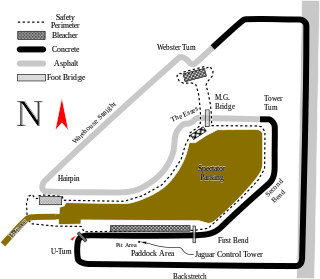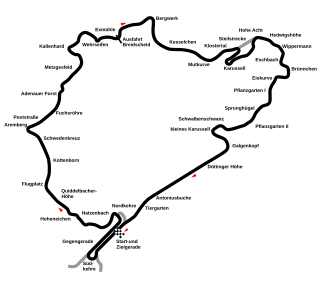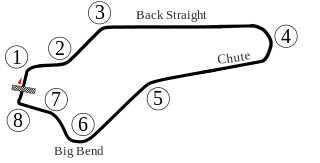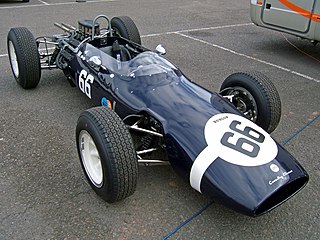McLaren Racing Limited is a British motor racing team based at the McLaren Technology Centre in Woking, Surrey, England. McLaren is best known as a Formula One constructor, the second oldest active team, and the second most successful Formula One team after Ferrari, having won 183 races, 12 Drivers' Championships and 8 Constructors' Championships. McLaren also has a history of competing in American open wheel racing, as both an entrant and a chassis constructor, and has won the Canadian-American Challenge Cup (Can-Am) sports car racing championship. The team is a subsidiary of the McLaren Group, which owns a majority of the team.

Bruce Leslie McLaren was a New Zealand racing car designer, driver, engineer, and inventor.

The 1959 United States Grand Prix was a Formula One motor race held on December 12, 1959, at Sebring International Raceway in Sebring, Florida. It was the last of 9 races in the 1959 World Championship of Drivers and the 8th and final in the 1959 International Cup for Formula One Manufacturers.It was the second United States Grand Prix, and the only occasion the race was held at the home of the 12 Hours of Sebring endurance sports car race, the Sebring International Raceway in Florida. The race was held over 42 laps of the 8.36-kilometre circuit for a total race distance of 351 kilometres.

The 1962 French Grand Prix was a Formula One motor race held at Rouen-Les-Essarts on 8 July 1962. It was race 4 of 9 in both the 1962 World Championship of Drivers and the 1962 International Cup for Formula One Manufacturers. The race was won by Dan Gurney, his first Formula One victory, driving a Porsche, that company's only win as a constructor in a Formula One championship race coming after three years of racing. It was the third time that the French Grand Prix was held at Rouen, last time being 1957.

The 1962 British Grand Prix was a Formula One motor race held at Aintree on 21 July 1962. It was race 5 of 9 in both the 1962 World Championship of Drivers and the 1962 International Cup for Formula One Manufacturers. This was the last race at Aintree. From 1963 onwards, the race would be held at Silverstone. Scotsman Jim Clark dominated the race, driving a Lotus 25. It was considered a power track, benefitting the light and powerful Lotus and Lola cars in particular. Ferrari were still sidelined due to the Italian metal workers' strike but managed to send one car for Phil Hill.

The 1962 German Grand Prix was a Formula One motor race held at the Nürburgring on 5 August 1962. It was race 6 of 9 in both the 1962 World Championship of Drivers and the 1962 International Cup for Formula One Manufacturers. The 15-lap race was won by BRM driver Graham Hill after he started from second position. John Surtees finished second for the Lola team and Porsche driver Dan Gurney came in third. The race was notable for having six different constructors taking the first six positions.

The 1962 Italian Grand Prix was a Formula One motor race held at Monza on 16 September 1962. It was race 7 of 9 in both the 1962 World Championship of Drivers and the 1962 International Cup for Formula One Manufacturers. The 86-lap race was won by BRM driver Graham Hill after he started from second position. His teammate Richie Ginther finished second and Cooper driver Bruce McLaren came in third.

The 1962 United States Grand Prix was a Formula One motor race held on October 7, 1962, at the Watkins Glen Grand Prix Race Course in Watkins Glen, New York. It was race 8 of 9 in both the 1962 World Championship of Drivers and the 1962 International Cup for Formula One Manufacturers. The 100-lap race was won by Lotus driver Jim Clark after starting from pole position. Graham Hill finished second for the BRM team and Cooper driver Bruce McLaren came in third.

The 1996 FIA Formula One World Championship was the 50th season of FIA Formula One motor racing. The championship commenced on 10 March and ended on 13 October after sixteen races. Two World Championship titles were awarded, one for Drivers and one for Constructors.

The 1989 FIA Formula One World Championship was the 43rd season of FIA Formula One motor racing. It began on 26 March and ended on 5 November. Alain Prost won his third Drivers' Championship, and McLaren won the Constructors' Championship.

The 1961 Formula One season was the 15th season of Formula One motor racing. It featured the 1961 World Championship of Drivers and the 1961 International Cup for F1 Manufacturers, which were contested concurrently from 14 May to 8 October over an eight race series. The season also included numerous non-championship races for Formula One cars.

The 1960 Formula One season was the 14th season of the FIA's Formula One motor racing. It featured the 11th FIA World Championship of Drivers, the third International Cup for F1 Manufacturers and numerous non-championship Formula One races. The World Championship commenced on 7 February and ended on 20 November after ten races.

The McLaren MP4/6 is a successful Formula One racing car designed by McLaren's Neil Oatley, Matthew Jeffreys, David North, David Neilson, Bob Bell and Mike Gascoyne; powered by the Honda RA121E V12 engine for use in the 1991 Formula One season. It was driven by reigning World Champion, Brazilian Ayrton Senna, and Austria's Gerhard Berger.

The McLaren M2B was the McLaren team's first Formula One racing car, used during the 1966 season. It was conceived in 1965 and preceded by the M2A development car. Designed by Robin Herd, the innovative but problematic Mallite material was used in its construction. The car was powered by Ford and Serenissima engines but both lacked power and suffered from reliability issues.

The McLaren M7A and its M7B, M7C and M7D variants were Formula One racing cars, built by McLaren and used in the world championship between 1968 and 1971. After two relatively unsuccessful years of Formula One competition, the M7A was used to score McLaren's first win at the 1968 Belgian Grand Prix.

The Cooper T51 was a Formula One and Formula Two racing car designed by Owen Maddock and built by the Cooper Car Company for the 1959 Formula One season. The T51 earned a significant place in motor racing history when Jack Brabham drove the car to become the first driver to win the World Championship of Drivers with an engine mounted behind them, in 1959. The T51 was raced in several configurations by various entrants until 1963 and in all no less than 38 drivers were entered to drive T51s in Grand Prix races.

Ecurie Bonnier, Ecurie Suisse, Joakim Bonnier Racing Team and Anglo-Suisse Racing Team were names used by Swedish racing driver Joakim Bonnier to enter his own cars in Formula One, Formula Two and sports car racing between 1957 and his death in 1972. Commonly the vehicles were entered for Bonnier himself, but he also provided cars for a number of other drivers during the period.

The Cooper T66 is a Formula One racing car from the Cooper Car Company, which was in use from 1963 to 1964.

The Cooper T73 is a 1.5-litre Formula One car, designed, developed and produced by Cooper Cars for the 1964 Formula One season.

The Cooper T77 is a 1.5-litre Formula One car entered in the 1965 Formula One World Championship by the Cooper Car Company.




















